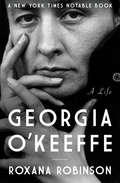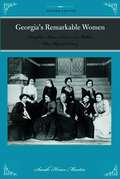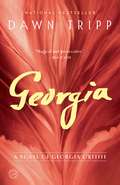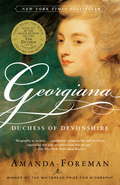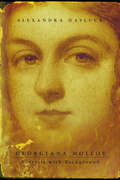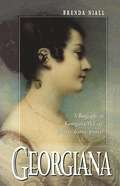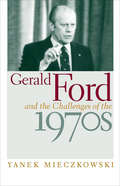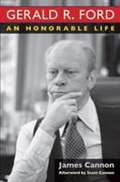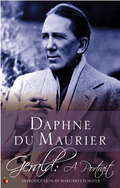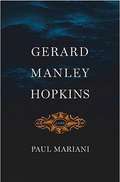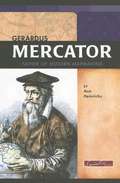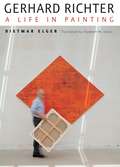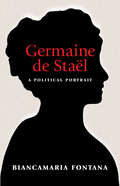- Table View
- List View
Georgia O'Keeffe (SparkNotes Biography Guide)
by SparkNotesGeorgia O'Keeffe (SparkNotes Biography Guide) Making the reading experience fun! SparkNotes Biography Guides examine the lives of historical luminaries, from Alexander the Great to Virginia Woolf. Each biography guide includes:An examination of the historical context in which the person lived A summary of the person&’s life and achievements A glossary of important terms, people, and events An in-depth look at the key epochs in the person&’s career Study questions and essay topics A review test Suggestions for further reading Whether you&’re a student of history or just a student cramming for a history exam, SparkNotes Biography guides are a reliable, thorough, and readable resource.
Georgia O'Keeffe: A Life (Biografia Circe Ser.)
by Roxana RobinsonA New York Times Notable Book: Roxana Robinson's definitive biography of Georgia O'Keeffe is a rich and revealing portrait of the iconic American artist. Artist Georgia O'Keeffe was born into a family of strong Midwestern farmwomen and taught self-reliance at an early age. Coming of age in the modern era, she went on to defy the social conventions of her time and lead a successful and emancipated life full of creativity, feminism, and austerity that has taken on mythic proportion. Roxana Robinson's multilayered book explores O'Keeffe's journey to personal and professional independence, the evolution of her art, and her most influential relationships. Written with the cooperation of O'Keeffe's family, and using sources unavailable during her lifetime, this biography presents the artist's own voice through her letters to family and friends. Robinson follows O'Keeffe from her childhood on a Wisconsin farm to the center of the New York art scene where she met her husband, photographer Alfred Stieglitz. Stieglitz championed O'Keeffe, exhibiting her work at his gallery and drawing her into his inner circle of early modernists. But O'Keeffe, ever caught between the demands of love and art, left New York to find inspiration in the New Mexico desert where she created some of her most renowned work. This vividly rendered, beautifully written account succeeds in capturing the passions, controversies, and contradictions in the life of an extraordinary woman.
Georgia Witness: A Contemporary Oral History of the State
by Stephen DosterDrawing on the voices of residents from across the state, this oral history reflects on life in Georgia as it evolved throughout the twentieth century. Author Stephen Doster grew up on St. Simons Island, one of Georgia&’s Golden Isles. He began interviewing fellow island residents and captured their personal histories in the book Voices from St. Simons. Now, Doster has expanded the scope of his work to encompass the entire state of Georgia. In Georgia Witness, Doster records the stories of residents from all across the state, capturing the unique life and history of its many communities. Here are the voices of influential figures and ordinary residents, individuals of varying backgrounds and ethnicities, all of whom remember and contribute to the legacy and lifeblood of the peach state.
Georgia's Bones
by Jen BryantGrowing up on a Wisconsin farm, Georgia O'Keeffe began gathering all sorts of objects — sticks and stones, flowers and bones. Although she was teased for her interest in unique shapes and sizes, young Georgia declared: “Someday, I’m going to be an artist” — and that is exactly what she became. Jen Bryant’s story of Georgia O’Keeffe celebrates the famous artist’s fascination with natural shapes, “common objects,” and her unusual way of looking at the world. Bethanne Andersen’s fluid, graceful illustrations capture the beauty of O’Keeffe’s work and spirit.
Georgia's Remarkable Women: Daughters, Wives, Sisters, and Mothers Who Shaped History (Remarkable American Women)
by Sara Hines MartinGeorgia's Remarkable Women: Daughters, Wives, Sisters, and Mothers Who Shaped History recognizes the women who helped to shape the Peach State. Female teachers, writers, entrepreneurs, and artists from across the state are illuminated through short biographies and archival photographs and paintings.Setting their own standards and following their passions, they continue to inspire new generations with their achievements. Meet Rebecca Latimer Felton, the first woman to sit as a U.S. senator; Juliette Gordon Low, the resilient founder of the Girl Scouts; Sarah Freeman Clarke, a painter who dared to pursue art and literature as a career; Gertrude "Ma" Rainey, the "Mother of the Blues," whose voice transcended race and class; and Margaret Mitchell, author of the enduring tale of survival, Gone with the Wind.
Georgia: A Novel of Georgia O'Keeffe
by Dawn TrippNATIONAL BESTSELLER * In a dazzling work of historical fiction in the vein of Nancy Horan's Loving Frank, Dawn Tripp brings to life Georgia O'Keeffe, her love affair with photographer Alfred Stieglitz, and her quest to become an independent artist. This is not a love story. If it were, we would have the same story. But he has his, and I have mine. In 1916, Georgia O'Keeffe is a young, unknown art teacher when she travels to New York to meet Stieglitz, the famed photographer and art dealer, who has discovered O'Keeffe's work and exhibits it in his gallery. Their connection is instantaneous. O'Keeffe is quickly drawn into Stieglitz's sophisticated world, becoming his mistress, protégé, and muse, as their attraction deepens into an intense and tempestuous relationship and his photographs of her, both clothed and nude, create a sensation. Yet as her own creative force develops, Georgia begins to push back against what critics and others are saying about her and her art. And soon she must make difficult choices to live a life she believes in.A breathtaking work of the imagination, Georgia is the story of a passionate young woman, her search for love and artistic freedom, the sacrifices she will face, and the bold vision that will make her a legend.Praise for Georgia"Complex and original . . . Georgia conveys O'Keeffe's joys and disappointments, rendering both the woman and the artist with keenness and consideration."--The New York Times Book Review"As magical and provocative as O'Keeffe's lush paintings of flowers that upended the art world in the 1920s . . . Tripp inhabits Georgia's psyche so deeply that the reader can practically feel the paintbrush in hand as she creates her abstract paintings and New Mexico landscapes. . . . Evocative from the first page to the last, Tripp's Georgia is a romantic yet realistic exploration of the sacrifices one of the foremost artists of the twentieth century made for love."--USA Today "Sexually charged . . . insightful . . . Dawn Tripp humanizes an artist who is seen in biographies as more icon than woman. Her sensuous novel is as finely rendered as an O'Keeffe painting."--The Denver Post"A vivid work forged from the actual events of O'Keeffe's life . . . [Tripp] imbues the novel with a protagonist who forces the reader to consider the breadth of O'Keeffe's talent, business savvy, courage and wanderlust. . . . [She] is vividly alive as she grapples with success, fame, integrity, love and family."--Salon "Masterful . . . The book is a lovely portrayal of an iconic artist who is independent and multidimensional. Tripp's O'Keeffe is a woman hoping to break free of conventional definitions of art, life and gender, as well as a woman of deep passion and love."--Milwaukee Journal Sentinel "O'Keeffe blazes across the pages in Tripp's tour de force about this indomitable woman. . . . Tripp has hit her stride here, bringing to life one of the most remarkable artists of the twentieth century with veracity, heart, and panache."--Publishers Weekly (starred review)"I devoured this dazzling novel about an American icon. Dawn Tripp brings Georgia O'Keeffe so fully to life on every page and, with great wisdom, examines the very nature of love, longing, femininity, and art."--J. Courtney Sullivan, New York Times bestselling author of Maine and The EngagementsFrom the Hardcover edition.
Georgiana
by Amanda ForemanThe winner of Britain's prestigious Whitbread Prize and a bestseller there for months, this wonderfully readable biography offers a rich, rollicking picture of late-eighteenth-century British aristocracy and the intimate story of a woman who for a time was its undisputed leader.Lady Georgiana Spencer was the great-great-great-great-aunt of Diana, Princess of Wales, and was nearly as famous in her day. In 1774, at the age of seventeen, Georgiana achieved immediate celebrity by marrying one of England's richest and most influential aristocrats, the Duke of Devonshire. Launched into a world of wealth and power, she quickly became the queen of fashionable society, adored by the Prince of Wales, a dear friend of Marie-Antoinette, and leader of the most important salon of her time. Not content with the role of society hostess, she used her connections to enter politics, eventually becoming more influential than most of the men who held office. Her good works and social exploits made her loved by the multitudes, but Georgiana's public success, like Diana's, concealed a personal life that was fraught with suffering. The Duke of Devonshire was unimpressed by his wife's legendary charms, preferring instead those of her closest friend, a woman with whom Georgiana herself was rumored to be on intimate terms. For over twenty years, the three lived together in a jealous and uneasy ménage à trois, during which time both women bore the Duke's children--as well as those of other men.Foreman's descriptions of Georgiana's uncontrollable gambling, all- night drinking, drug taking, and love affairs with the leading politicians of the day give us fascinating insight into the lives of the British aristocracy in the era of the madness of King George III, the American and French revolutions, and the defeat of Napoleon. A gifted young historian whom critics are already likening to Antonia Fraser, Amanda Foreman draws on a wealth of fresh research and writes colorfully and penetratingly about the fascinating Georgiana, whose struggle against her own weaknesses, whose great beauty and flamboyance, and whose determination to play a part in the affairs of the world make her a vibrant, astonishingly contemporary figure.
Georgiana Molloy: Portrait with Background
by Alexandra HasluckThe story of a remarkable pioneer who discovered in the strange colonial wilderness the splendour and richness of Australia's unique flora. In 1829 Georgiana Molloy moved from the middle-class comfort of the English border country to an isolated wilderness on the opposite side of the world. The young bride and her husband, Captain John Molloy, were among a small party that founded the settlement of Augusta on Western Australia's south-west coast. A pioneer of great courage and capacity, Georgiana was presented with seemingly overwhelming trials and hardships. But she was a woman who was never defeated by circumstance, and never ceased to find enjoyment and satisfaction in her life. One of her enduring legacies is her study and identification of much of the unique local flora. A vivid portrait of an extraordinary woman.
Georgiana: A biography of Georgiana McCrae, painter, diarist, pioneer
by Brenda NiallAfter a childhood among artists, French �migr�s and English radicals in Regency London, Georgiana lived as a young woman at her father's castle in the Highlands. A gifted portraitist, professionally trained in London, she earned her own living in Edinburgh before making the choice between marriage and a career. After marrying Andrew McCrae in 1830 she followed her husband in his erratic progress from Edinburgh to London and then to Port Phillip, where he was successively lawyer, squatter and goldfields magistrate. The varied fortunes of the McCraes are recounted in a story whose tragic elements are counter-balanced by the strength of mind, the lively wit and creativity of Georgiana. By allowing Georgiana's own voice to be heard through her letters and journals Brenda Niall has brought a legendary colonial figure into authentic vibrant life.
Gerald Ford and the Challenges of the 1970s
by Yanek MieczkowskiA reappraisal of the brief presidency of Gerald Ford, called to leadership in the midst of scandal, stagflation, and an energy crisis. For many Americans, Gerald Ford evokes an image of either an unelected president who abruptly pardoned his corrupt predecessor or an accident-prone klutz spoofed on Saturday Night Live. In this book, Yanek Mieczkowski reexamines Ford&’s two and a half years in office, showing that his presidency successfully confronted the most vexing crisis of the postwar era. Viewing the 1970s primarily through the lens of economic events, Mieczkowski argues that Ford&’s understanding of the national economy was better than any modern president&’s; that he oversaw a dramatic reduction of inflation; and that he attempted to solve the energy crisis with judicious policies. Throughout his presidency, Ford labored under the legacy of Watergate. Democrats scored landslide victories in the 1974 midterm elections, and within an anemic Republican Party, the right wing challenged Ford&’s leadership, even as pundits predicted the GOP&’s death. Yet Ford reinvigorated the party and fashioned a 1976 campaign strategy against Jimmy Carter that brought him from thirty points behind to a dead heat on election day. Drawing on numerous personal interviews with former President Ford, cabinet officials, and members of the Ninety-fourth Congress, Mieczkowski presents the first major work on Ford in more than a decade, combining the best of biography and presidential history to paint an intriguing portrait of a president, his times, and his legacy. &“This ambitious work calls for a reexamination of the Ford presidency in light of the formidable challenges he faced upon taking office. A welcome and important addition to the literature on the Ford presidency.&” ―Library Journal
Gerald R. Ford (The American Presidents Series)
by Arthur M. Schlesinger Douglas G. BrinkleyThe 'accidental' president whose innate decency and steady hand restored the presidency after its greatest crisis. When Gerald R. Ford entered the White House in August 1974, he inherited a presidency tarnished by the Watergate scandal, the economy was in a recession, the Vietnam War was drawing to a close, and he had taken office without having been elected. Most observers gave him little chance of success, especially after he pardoned Richard Nixon just a month into his presidency, an action that outraged many Americans, but which Ford thought was necessary to move the nation forward. Many people today think of Ford as a man who stumbled a lot--clumsy on his feet and in politics--but acclaimed historian Douglas Brinkley shows him to be a man of independent thought and conscience, who never allowed party loyalty to prevail over his sense of right and wrong. As a young congressman, he stood up to the isolationists in the Republican leadership, promoting a vigorous role for America in the world. Later, as House minority leader and as president, he challenged the right wing of his party, refusing to bend to their vision of confrontation with the Communist world. And after the fall of Saigon, Ford also overruled his advisers by allowing Vietnamese refugees to enter the United States, arguing that to do so was the humane thing to do. Brinkley draws on exclusive interviews with Ford and on previously unpublished documents (including a remarkable correspondence between Ford and Nixon stretching over four decades), fashioning a masterful reassessment of Gerald R. Ford's presidency and his under-appreciated legacy to the nation.
Gerald R. Ford: An Honorable Life
by James Scott Cannon“Not since Harry Truman succeeded Franklin D. Roosevelt twenty-nine years earlier had the American people known so little about a man who had stepped forward from obscurity to take the oath of office as President of the United States. ” —from Chapter 4 This is a comprehensive narrative account of the life of Gerald Ford written by one of his closest advisers, James Cannon. Written with unique insight and benefiting from personal interviews with President Ford in his last years, Gerald R. Ford: An Honorable Life is James Cannon’s final look at the simple and honest man from the Midwest.
Gerald R. Ford: Thirty-eighth President Of The United States
by David R. CollinsPresents the life of Gerald Ford, including his childhood, education, employment, and political career.
Gerald: A Portrait
by Daphne Du Maurier"A remarkable book...brilliant comic writing." --The Times (UK) Sir Gerald du Maurier was the preeminent actor-manager of his day, knighted in 1922 for his services to the theater. Published within six months of her father's death, Daphne du Maurier's frank portrait was considered shocking by many of his admirers-but it was a huge success, winning her critical acclaim and launching her career. Here, Daphne captures the spirit and charm of the charismatic actor who played the original Captain Hook, amusingly recounting his eccentricities, his humor, as well as his darker side.
Gerald: A Portrait (Virago Modern Classics #113)
by Daphne Du MaurierFROM THE BESTSELLING AUTHOR OF REBECCASir Gerald du Maurier was the most celebrated actor-manager of his day, knighted for his services to the theatre in 1922, and the father to one of the most enduring writers of the twentieth century. Published within six months of her father's death, this frank biography was considered shocking by many of his admirers - but it was a huge success, winning Daphne du Maurier critical acclaim and launching her career.In Gerald: A Portrait, Daphne du Maurier captures the spirit and charm of the charismatic actor who played the original Captain Hook, amusingly recalling his eccentricities and his sense of humour, and sensitively portraying the darker side of his nature and his bouts of depression.A remarkable book . . . brilliant comic writing - The Times
Gerald: A Portrait (Vmc Ser. #654)
by Daphne Du MaurierFROM THE BESTSELLING AUTHOR OF REBECCASir Gerald du Maurier was the most celebrated actor-manager of his day, knighted for his services to the theatre in 1922, and the father to one of the most enduring writers of the twentieth century. Published within six months of her father's death, this frank biography was considered shocking by many of his admirers - but it was a huge success, winning Daphne du Maurier critical acclaim and launching her career.In Gerald: A Portrait, Daphne du Maurier captures the spirit and charm of the charismatic actor who played the original Captain Hook, amusingly recalling his eccentricities and his sense of humour, and sensitively portraying the darker side of his nature and his bouts of depression.A remarkable book . . . brilliant comic writing - The Times
Gerard Kenney 3-Book Bundle: Lake of the Old Uncles / Dangerous Passage / Ships of Wood and Men of Iron
by Gerard KenneyTreacherous and remote, the Arctic and the fabled Northwest Passage have long been elusive goals for explorers. Gerard Kenney shares stories of exploration in the Arctic region. This three-book bundle includes: Ships of Wood and Men of Iron: A Norewegian-Canadian Saga of Exploration in the High Arctic A history of explorations of the Arctic in Canada, beginning with Otto Sverdrup's Norwegian expedition. Dangerous Passage: Issues in the Arctic The story of the opening up of the Northwest Passage and the ensuing potential risks to the Arctic environment and Canadian sovereignty are explored. Lake of the Old Uncles Kenney recounts a journey that led him to build a log cabin on the small, inaccessible Lake of Old Uncles and shares a personal philosophy inspired by Henry David Thoreau.
Gerard Manley Hopkins
by Paul MarianiAn insightful and inspirational biography of the heroic and spiritual poet. Gerard Manley Hopkins (1844?1889) may well have been the most original and innovative poet writing in the English language during the nineteenth century. Yet his story of personal struggle, doubt, intense introspection, and inward heroism has never been told fully. As a Jesuit priest, Hopkins?s descent into loneliness and despair and his subsequent recovery are a remarkable and inspiring spiritual journey that will speak to many readers, regardless of their faith or philosophies. Paul Mariani, an award-winning poet himself and author of a number of biographies of literary figures, brilliantly integrates Hopkins?s spiritual life and his literary life to create a rich and compelling portrait of a man whose work and life continue to speak to readers a century after his death.
Gerardo Nieto: La música tropical en primera persona
by Carlos Hernández GreneBiografía de la figura de Gerardo Nieto, el exponente y referente de la música tropical uruguaya, desde diversos ángulos. Gerardo Nieto es uno de los máximos exponentes y referentes de la música tropical en nuestro país. En estas páginas se hace un repaso por la trayectoria musical del cantante, en sus treinta años de carrera, que no deja de lado aspectos de su vida personal. A través de esta biografía, conoceremos en profundidad el nacimiento de Karibe con K, la orquesta tropical récord de los noventa, pero también el mundo de la música tropical uruguaya desde sus comienzos. Este libro invita a una mirada del género tropical distinta, y en especial a uno de sus protagonistas: Gerardo Nieto.
Gerardus Mercator: Father of Modern Mapmaking
by Ann HeinrichsMercator was destined to be one of the most famous mapmakers in history. Before his time, many maps were as much about myths as geographical reality, filled with exotic creatures and fabled lands. But he turned cartography, or map-making, into a science. He based his maps on firsthand reports, using mathematical calculations whenever possible to pinpoint locations.
Gerhard Richter: A Life In Painting
by Dietmar Elger Elizabeth M. SolaroThis fascinating book offers unprecedented insight into artist Gerhard Richter's life and work. From his childhood in Nazi Germany to his time in the West during the turbulent 1960s and '70s, this work presents a complete portrait of the often-reclusive Richter.
Germ Hunter: A Story about Louis Pasteur
by Elaine Marie AlphinGrowing up in the 1830s, Louis Pasteur saw the horrifying effects of diseases like rabies and tuberculosis. Filled with curiosity and imagination, Pasteur began a lifelong search for answers to his many questions about diseases. Although many scientists disagreed with his unusual ideas, his discoveries made him famous. Through his dedication and insight, Pasteur saved millions of lives and laid the groundwork for future medical advancements.
Germ Wars
by Richard LaceyRichards Lacey's autobiography describes a life of science and medicine over seventy years. Abuse at boarding school is followed by optimism as a Cambridge student marred by the realisation fifty years later of the involvement of his aunt with spy Kim Philby, whom he now believes was the character on which James Bond was based. After early clinical medicine, basic research at Bristol on antibiotics created conflict with the pharmaceutical industry. Academic malice forces a move to Kings Lynn as NHS consultant when Richard is delighted that a toxic antibiotic is virtually banned. The move to Leeds as Professor provokes disputes over the rise of food poisoning. After exposure of the BSE cover-up, readers will question whether Richard's forced early retirement was a conspiracy. Finally, a way to remove our beloved NHS from party politics is suggested.
Germaine Dulac: A Cinema of Sensations
by Tami WilliamsBest known for directing the Impressionist classic The Smiling Madame Beudet and the first Surrealist film The Seashell and the Clergyman, Germaine Dulac, feminist and pioneer of 1920s French avant-garde cinema, made close to thirty fiction films as well as numerous documentaries and newsreels. Through her filmmaking, writing, and cine-club activism, Dulac's passionate defense of the cinema as a lyrical art and social practice had a major influence on twentieth century film history and theory. In Germaine Dulac: A Cinema of Sensations, Tami Williams makes unprecedented use of the filmmaker's personal papers, production files, and archival film prints to produce the first full-length historical study and critical biography of Dulac. Williams's analysis explores the artistic and sociopolitical currents that shaped Dulac's approach to cinema while interrogating the ground breaking techniques and strategies she used to critique conservative notions of gender and sexuality. Moving beyond the director's work of the 1920s, Williams examines Dulac's largely ignored 1930s documentaries and newsreels establishing clear links with the more experimental impressionist and abstract works of her early period. This vivid portrait will be of interest to general readers, as well as to scholars of cinema and visual culture, performance, French history, women's studies, queer cinema, in addition to studies of narrative avant-garde, experimental, and documentary film history and theory.
Germaine de Stael: A Political Portrait
by Biancamaria FontanaGermaine de Staël (1766-1817) is perhaps best known today as a novelist, literary critic, and outspoken and independent thinker. Yet she was also a prominent figure in politics during the French Revolution. Biancamaria Fontana sheds new light on this often overlooked aspect of Staël's life and work, bringing vividly to life her unique experience as a political actor in a world where women had no place.The banker's daughter who became one of Europe's best-connected intellectuals, Staël was an exceptionally talented woman who achieved a degree of public influence to which not even her wealth and privilege would normally have entitled her. During the Revolution, when the lives of so many around her were destroyed, she succeeded in carving out a unique path for herself and making her views heard, first by the powerful men around her, later by the European public at large. Fontana provides the first in-depth look at her substantial output of writings on the theory and practice of the exercise of power, setting in sharp relief the dimension of Staël's life that she cared most about--politics. She was fascinated by the nature of public opinion, and believed that viable political regimes were founded on public trust and popular consensus. Fontana shows how Staël's ideas were shaped by the remarkable times in which she lived, and argues that it is only through a consideration of her political insights that we can fully understand Staël's legacy and its enduring relevance for us today.

